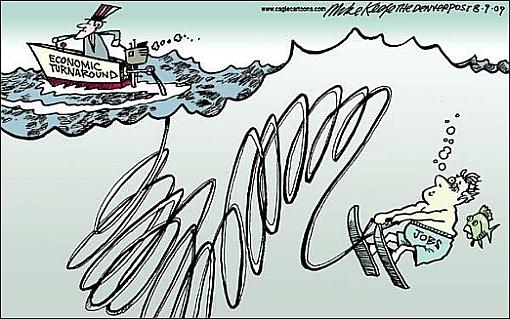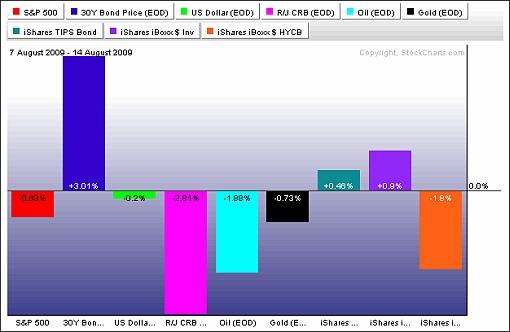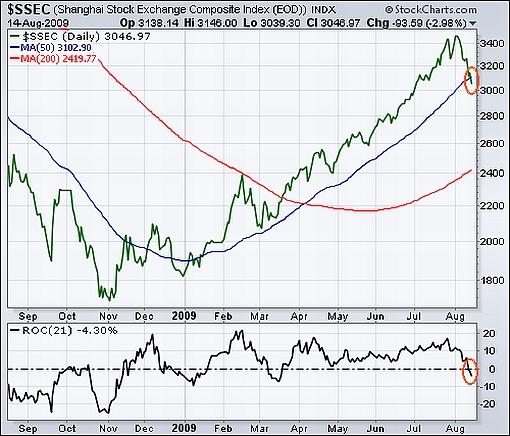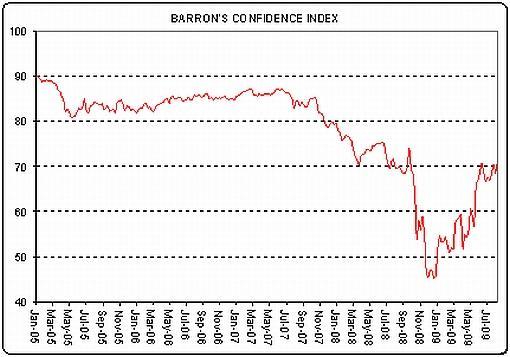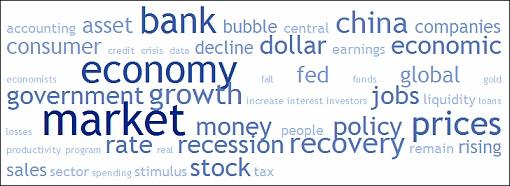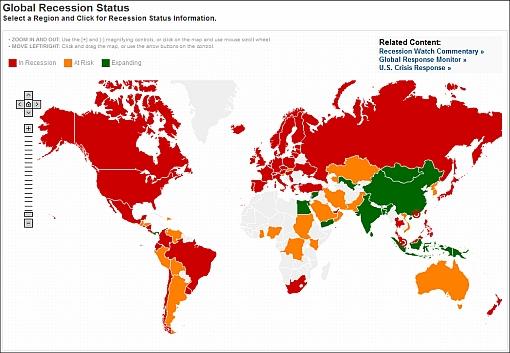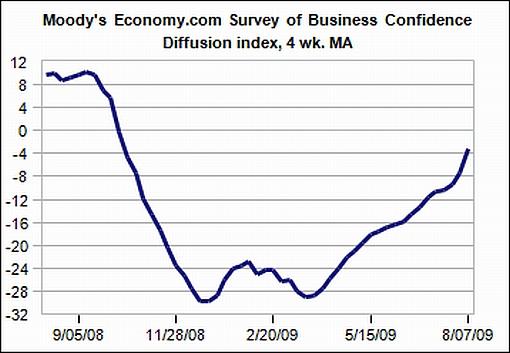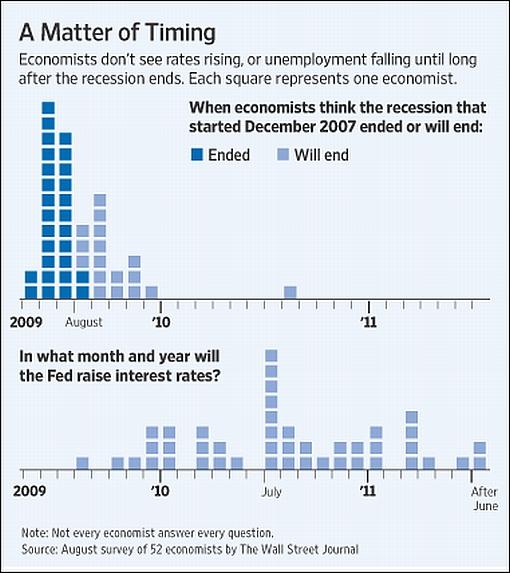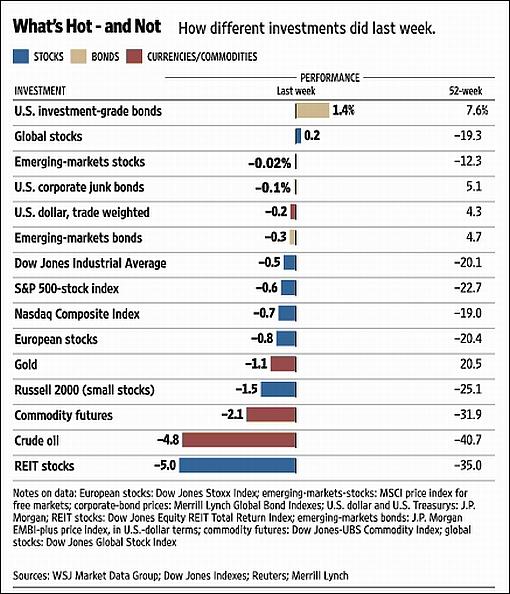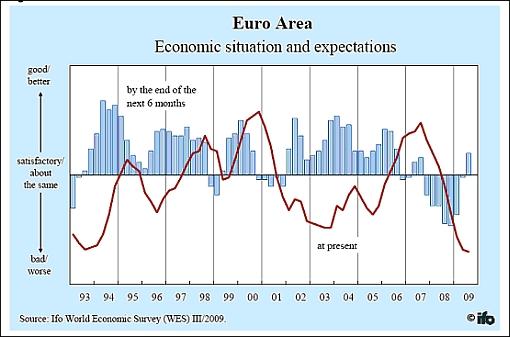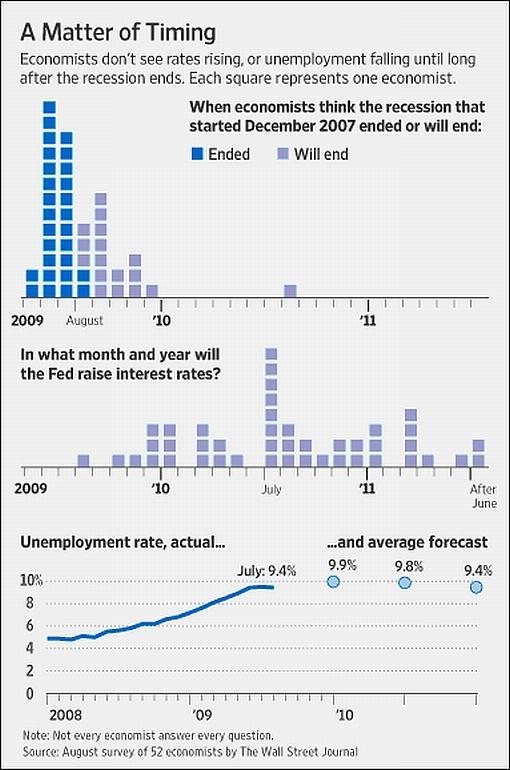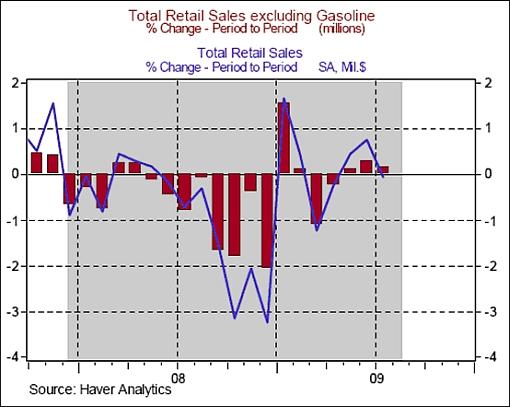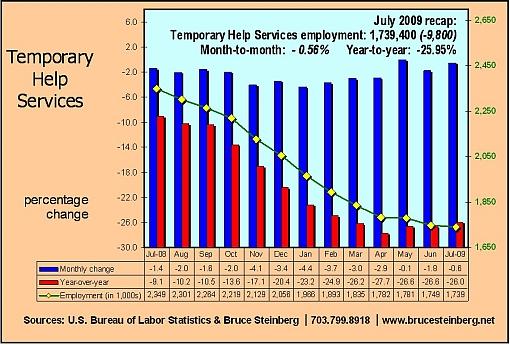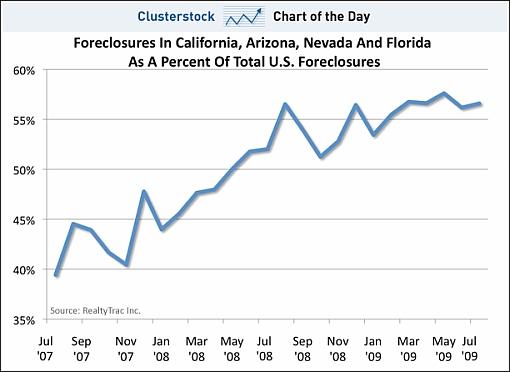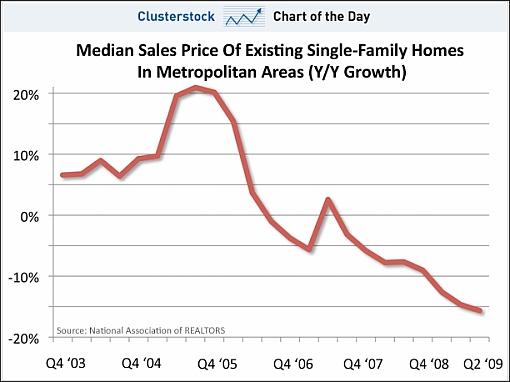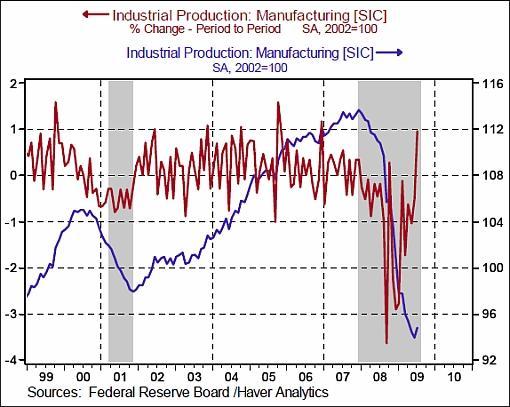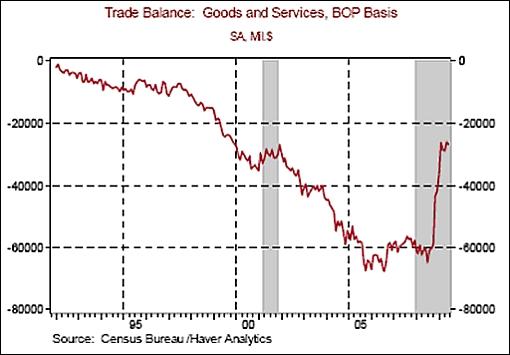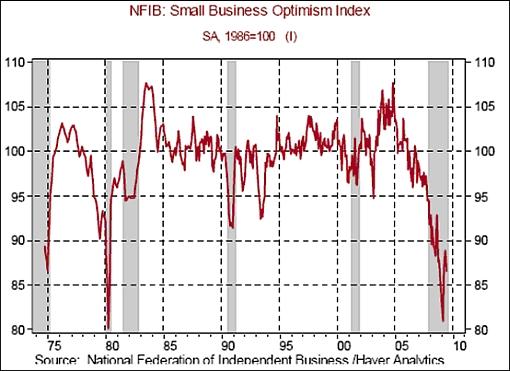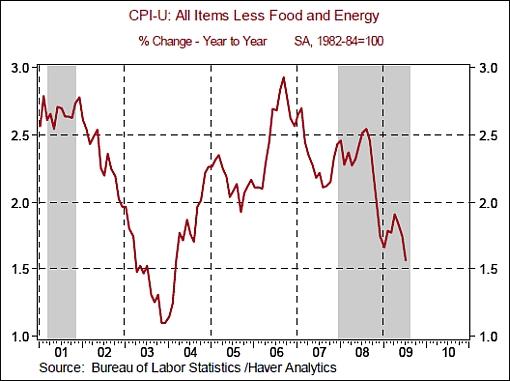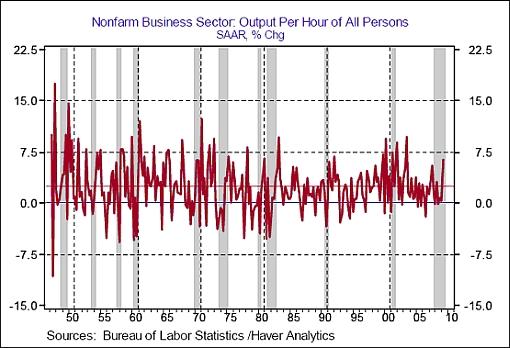Stock Market Rally Celebrations Come to an Abrupt Halt
Stock-Markets / Financial Markets 2009 Aug 16, 2009 - 04:07 PM GMT During the week marking the second anniversary of the start of the credit crunch, stocks, copper, nickel, zinc and sugar recorded fresh 2009 highs. But the celebrations came to an abrupt end as caution crept back into investors’ vocabulary on Friday when it dawned upon pundits that markets were running away from economic reality. On top of that, Chinese equities - a leading stock market on the way up - saw a reversal of fortune and declined to a five-week low.
During the week marking the second anniversary of the start of the credit crunch, stocks, copper, nickel, zinc and sugar recorded fresh 2009 highs. But the celebrations came to an abrupt end as caution crept back into investors’ vocabulary on Friday when it dawned upon pundits that markets were running away from economic reality. On top of that, Chinese equities - a leading stock market on the way up - saw a reversal of fortune and declined to a five-week low.
This is where the Ecclesiastes-based lyrics of the Byrds’s classic, Turn, Turn, Turn, started resounding in my head: “To everything (turn, turn, turn), There is a season (turn, turn, turn), And a time for every purpose, under heaven, A time to gain, a time to lose …” (Click here for audio.)
Source: Mike Keefe (hat tip: The Big Picture)
Paul Kasriel, chief economist of Northern Trust, reports that the meeting statement of the Federal Open Market Committee (FOMC), released on Wednesday, was a bit more optimistic about the near-term economic environment, changing its language from “the pace of economic contraction is slowing” at the June 24 meeting to “economic activity is leveling out”. However, the communiqué also said that household spending would be constrained by “sluggish income growth”, in addition to the other constraining factors mentioned in the June 24 statement - “ongoing job losses, lower household wealth, and tight credit”.
“Given our current view that the recovery is going to be subdued and uneven over the next several quarters, we do not expect any federal funds rate increases from the FOMC until June 2010, at the earliest,” said Kasriel.
Shorter-dated US, UK and other government bond yields - securities that are sensitive to interest rate movements - declined on indications that benchmark interest rates would remain at low levels for an extended period of time. Longer-dated US yields also fell after the Fed announced that its Treasury purchase program would be extended until October. “The point is the Fed said it would keep the punch bowl open an extra month but it would not increase the punch that is already in the bowl. It will just dole it out in smaller increments over an extra month,” remarked Bill King (The King Report).
To James Grant (Grant’s Interest Rate Observer) the level of Treasury yields spells danger. He said: “Vacation-time thought experiment: With the knowledge that the US government will be borrowing as much as $3.5 trillion from the public in fiscal years 2009, 2010 and 2011, approximately matching the Treasury’s cumulative borrowing between 1789 and 1994, would you have guessed that the yield on the 10-year Note would today be hovering in the neighborhood of only 3.7%? If ‘yes’ is your answer, you must not go away on vacation this month. You have too hot a hand to stay away from the office.”
The past week’s performance of the major asset classes is summarized by the chart below, showing risky assets starting to take a breather.
Source: StockCharts.com
A summary of the movements of major global stock markets for the past week, as well as various other measurement periods, is given in the table below.
The MSCI World Index (+0.1%) and MSCI Emerging Markets Index (unchanged) marked time last week, but are still showing solid year-to-date gains of +15.6% and +50.4% respectively. As weakness crept in towards the close of the week, the US and a number of other markets snapped a winning streak of four straight weeks. Emerging markets underperformed developed markets for the second week running since the beginning of May, indicating signs of risk appetite abating somewhat.
Click here or on the table below for a larger image.
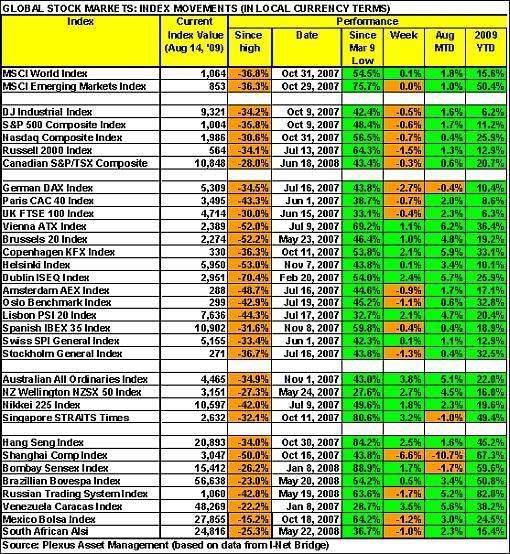
Top performers in the stock markets this week were Bulgaria (+9.4%), Lithuania (+6.7%), Estonia (+6.5%), Vietnam (+5.5%) and Venezuela (+4.5%). The top three positions were again occupied by countries from Eastern Europe that are still playing catch-up as the scare of a banking collapse in the region dissipates. At the bottom end of the performance rankings, countries included China (‑6.6%, last week -4.4%), Nigeria (-4.5%), Luxembourg (-3.6%), Cyprus (-3.2%) and Israel (-2.8%).
After surging by 90.7% since the beginning of the year and notching up seven straight weeks of gains, the Chinese Shanghai Composite Index has now declined by 12.2% since its peak of August 4, taking the Index back to its early-July level. On Friday, the Index (3,047) dropped to below its 50-day moving average (3,103), but it is still comfortably trading above its 200-day line (2,420). The Rate-of-Change Indicator (black line in the bottom section of the chart) has broken below the zero line, thereby flashing a sell signal.
Source: StockCharts.com
Of the 94 stock markets I keep on my radar screen, a majority of 63% (last week 74%) recorded gains, 33% (21%) showed losses and 4% (5%) remained unchanged. (Click here to access a complete list of global stock market movements, as supplied by Emerginvest.)
John Nyaradi (Wall Street Sector Selector) reports that as far as exchange-traded funds (ETFs) are concerned, the winners for the week included Vanguard Extended Duration Treasury (EDV) (+5.2%), iShares MSCI Austria (EWO) (+4.4%) and WisdomTree Japan SmallCap Dividend (DFJ) (+3.8%).
At the bottom end of the performance rankings, ETFs included Market Vectors Solar Energy (KWT) (-5.8%), SPDR KBW Regional Banking (KRE) (‑5.1%) and iShares Cohen & Steers Realty Majors (ICF) (-4.9%).
On the credit front, an indicator worth monitoring is the Barron’s Confidence Index. This Index is calculated by dividing the average yield on high-grade bonds by the average yield on intermediate-grade bonds. The discrepancy between the yields is indicative of investor confidence. There has been a solid improvement in the ratio since its all-time low in December, showing that bond investors are growing more confident and have started opting for more speculative bonds over high-grade bonds (albeit not to the extent to restore the ratio to pre-crisis levels). As to be expected, there is also a close relationship between the Index and the movement of the benchmark US stock market indices.
Source: I-Net Bridge
Economists of the ilk of John Mauldin (Thoughts from the Frontline) and Nouriel Roubini (RGE Monitor) warn that the coming “recovery” may be anemic and not much more than a “statistical recovery”. In this regard, the quote du jour this week comes from Lawrence Mishel, president of the Economic Policy Institute, who described the situation as follows in The Washington Post: “Economists are using one concept of recession that is at total variance with how a normal human being thinks of it. A normal human being thinks of a recession as: You fell into a hole, and as long as you’re in a hole, you’re in a recession. Economists think of [a recession's end] as … when the economy stops shrinking.”
Other news is that the Federal Deposit Insurance Corp (FDIC) seized Colonial Bank on Friday - the sixth largest bank failure in US history. Additionally, regulators closed four more banks, bringing the tally of US bank failures in 2009 to 77, including 32 since July 1.
Next, a tag cloud of all the articles I read during the past week. This is a way of visualizing word frequencies at a glance. Key words such as “market”, “economy”, “bank”, “prices” and “China” featured prominently. Interestingly, “recovery” also moved up the ranks as the global economy seems to have turned the corner.
The key moving-average levels for the major US indices, the BRIC countries and South Africa (where home is) are given in the table below. With the exception of the Chinese Shanghai Composite Index, which fell below its 50-day moving average on Friday, all the indices are trading above their respective 50- and 200-day moving averages. The 50-day lines are also in all instances above the 200-day lines and therefore not threatening the bullish “golden crosses” established when the 50-day averages broke upwards through the 200-day averages.
The steepening uptrend of a number of indices has become frothy and some degree of reversion to mean is probably overdue. I believe this process - which could take the form of either a pullback or a consolidation (i.e. ranging) pattern - might have commenced with the declines in China and elsewhere. The July lows are also given in the table, as these levels may offer support for a number of the indices.
Click here or on the table below for a larger image.
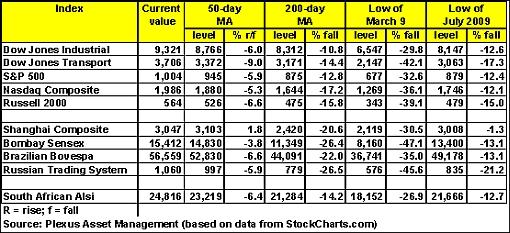
Long-timer Richard Russell (Dow Theory Letters) said: “Some of the smartest and most successful men and women in the world disagree as to whether we are dealing with a correction in an ongoing bear market - or whether we are dealing with a new bull market. Nobody on the planet possesses the final, ultimate answer. I happen to believe we’re dealing with an upward correction in an ongoing bear market, and that opinion is what keeps me on the edge of my seat. I’m worried about the economy, I’m worried about the future, and I’m worried about the market itself.
“Because this correction, so far, has been impressive, many analysts are calling it a ‘cyclical bull market’ instead of a bear market rally. I don’t care what you call it, if I’m correct, if, indeed, we are in a rally in a bear market, I want to be on my guard. I went through a number of these ‘cyclical bull markets’ during the 1966 to 1980 bear market, and I saw a lot of investors lose their shirts when those various bear market rallies unexpectedly topped out.”
Doug Kass (TheStreet.com), who accurately called the March bottom, is now outright bearish, saying: “The market optimism we are now experiencing in the expectation of a clean hand-over of the baton of stimulation from the consumer (2000-2006) to the government (2008-??) might be more short-lived than many believe, as the price of stimulation, regardless of whether its source is the private or public sector, holds the promise of being more of a growth retardant. With the debt supercycle continuing apace (but in a public sector context), the fragility and inherently unstable ‘balance of financial terror’ argue for a not-so-benign and extremely volatile stock market future.
“… the margin of safety is becoming ever more thin as the enemy of the rational buyer, namely optimism, reaches new heights. … since a self-sustaining economic recovery appears doubtful, I do not believe we have started a new bull market. Rather, it is more than likely that economic growth will disappoint in late 2009/early 2010 as the domestic economy confronts many of the emerging secular challenges.”
On Friday, I published a short post on Chinese equities and said: “… it looks if more downside is in store for the Shanghai Composite Index and it would not come as a surprise if lower Chinese equities serve as the catalyst for a well-deserved pullback in global stock markets.” With world markets coming off the boil by the close of the week, China may already have started leading world markets lower. A much-needed pullback/consolidation of frothy markets looks likely - be cautious out there!
For more discussion on the direction of financial markets, see my recent posts “Stock mrkets disconnected from economy“, “All eyes on Chinese equities“, “Bob Prechter - ‘Step aside’ from long positions“, “When will the rally end?“, “Revisiting Bob Farrell’s rule #9” and “More on Bob Farrell’s rule #8. (And do make a point of listening to Donald Coxe’s webcast of August 13, which can be accessed from the sidebar of the Investment Postcards site.)
Economy
The Recession Status Map below, courtesy of Dismal Scientist Economy.com, aggregates growth statistics from around the world and allows one to see at a glance which economies are in recession, at risk or beginning to recover. Click on the map to link to the interactive version.
Source: Dismal Scientist
Although the recessionary conditions still dominate, global business confidence turned positive last week for the first time since early last October. (The chart below uses a four-week moving average and is therefore not yet reflecting the break above the zero line.) “The gains in sentiment are evident across the entire global economy and all industries,” said the latest Survey of Business Confidence of the World by Moody’s Economy.com. Businesses’ broad assessment of the current economic environment and the outlook into early 2010 are particularly upbeat. However, despite the steady improvement in confidence, the Survey results remain consistent with a global economy that is still in recession.
Source: Moody’s Economy.com
The German and French economies unexpectedly bounced back in the second quarter - both grew at 0.3% in the three months to the end of June after having suffered four straight quarters of negative growth. This resulted in GDP in the Eurozone falling by only 0.1% in the last quarter. Meanwhile, the UK’s GDP lags the OECD economies with a second-quarter decline of 0.8%.”
A snapshot of the week’s US economic reports is provided below. (Click on the dates to see Northern Trust’s assessment of the various data releases.)
Friday, August 14 • The factory sector has turned the corner • Inflation remains contained • Consumer Sentiment Index dips again
Thursday, August 13 • Gasoline prices bring down total retail sales in July • Jobless claims report - sum of continuing claims and special programs advances for second consecutive week
Wednesday, August 12 • FOMC meeting statement - the Fed defines “autumn” • Trade gap widens while exports also advance
Tuesday, August 11 • Q2 productivity surge is temporary • Small business optimism dips slightly in July
Also, Zillow.com reported (via Bloomberg) that almost one-quarter of US mortgage holders owed more than their homes were worth in the second quarter, expecting the figure to rise to as much as 30% by mid-2010 as job losses and foreclosures climb.
George Soros said in an interview with Reuters that the US economy had hit bottom and the current quarter would see positive growth due to the government’s stimulus spending. He said he did not believe the economy needed further stimulus money, notwithstanding calls for a second round of spending [from the likes of Nobel laureate Paul Krugman].
Meanwhile, a survey by The Wall Street Journal among 52 economists (with 47 respondents) reported that 27 participants said the recession had ended and 11 expected a trough this month or next. “Only six economists expect the Fed to raise the federal funds rate, now between 0% and 0.25%, this year. Most expect an increase at some point in 2010, but more than a quarter of respondents don’t see the rate moving until 2011 or later.”
Source: The Wall Street Journal, August 11, 2009.
Week’s economic reports
The US economic data reports for the week include the following:
Monday, August 17 Empire manufacturing Net long-term TIC flows
Tuesday, August 18 Building permits Housing starts PPI
Wednesday, August 19 None
Thursday, August 20 Initial jobless claims Leading economic indicators Philadelphia Fed
Friday, August 21 Existing home sales
Markets The performance chart obtained from the Wall Street Journal Online shows how different global financial markets performed during the past week.
Source: Wall Street Journal Online, August 14, 2009.
“Listening to the market, maximizing the bets that turn out and minimizing those that don’t, are the essence of how portfolio management works. Because nobody is right all the time, that discipline is the oft-overlooked secret of how real fortunes are made,” said Jonathan Hoenig (hat tip: Charles Kirk). Let’s hope the news items and quotes from market commentators included in the “Words from the Wise” review will assist Investment Postcards readers in making those fortunes.
For short comments - maximum 140 characters - on topical economic and market issues, web links and graphs, you can also follow me on Twitter by clicking here.
That’s the way it looks from Cape Town. (Our entire household is down with flu, but fortunately a less harmful strain than H1N1, which is rife in the neighborhood. I guess this too will “turn, turn, turn”, as the Byrds sang.)
Hat tip: Leo Kolivakis, Pension Pulse
Charlie Rose: A conversation with Kurt Andersen about his book “Reset: How This Crisis Can Restore Our Values and Renew America”
Financial Times: Eurozone data raise hopes for recovery “The German and French economies unexpectedly bounced back in the second quarter, raising hopes that the worst of the economic crisis is coming to an end in the eurozone.
“The region’s two biggest economies, which had each suffered four consecutive quarters of negative growth, both grew 0.3% in the three months to the end of June, figures showed on Thursday.
“The figures confounded economists who had predicted contractions in each country again after German gross domestic product plummeted 3.5% and French GDP shrank by 1.3% in the first quarter.
“As a result, GDP in the 16-nation currency bloc fell only 0.1% in the last quarter, the European statistics office said, cheering economists who had expected a decline of 0.5% after a drop of 2.5% in the previous quarter.
“The better than expected performance echoed that of the US economy, which shrank only 0.3% in the second quarter on a quarterly basis. But the UK saw its GDP shrink 0.8%, prompting criticism of the government’s handling of the economy.
“Erik Nielsen, chief economist for Europe at Goldman Sachs in London, said: ‘If you look at the US and Europe, pretty much everyone had a better second quarter than expected a few months ago - with the exception of the UK.’”
Source: Gerrit Wiesmann and Ben Hall, Financial Times, August 13, 2009.
Ifo: Improvement in economic climate for euro area “The Ifo World Economic Climate for the euro area improved in the third quarter of 2009 for the second time in succession. The increase in the Ifo indicator was solely the result of more favourable expectations for the coming six months; the assessments of the current economic situation, in contrast, still remain at an historical low.
“The current economic situation is still assessed as definitely unfavourable in almost all countries of the euro area. The expectations for the coming six months, however, have brightened in the euro area. Especially in Germany, Austria, France and the Netherlands, the World Economic Survey (WES) experts anticipate a clear improvement, and in Italy, Portugal, Slovenia, Slovakia, Belgium, Spain and Finland they foresee at least a stabilisation of the economic situation in the coming six months. A continued pessimistic view, albeit somewhat weaker than in the previous quarter, prevails among WES experts in Ireland and Greece.”
Source: IFO, August 12, 2009.
Alexander Redman (Credit Suisse): Food price inflation “A fresh spike in food prices due to supply and demand imbalances could have serious implications for central bank policy, says Alexander Redman, strategist at Credit Suisse.
“He notes the sugar price is at its highest for more than two decades, rice trades at a large premium to its two-decade real average and wheat is close to the 20-year (constant 2009 dollar) average price.
“Mr Redman says a major factor behind the elevated sugar price is the poor Indian monsoon rainfall - which led to the country’s driest June for 50 years.
“‘This has clear implications for global food production volume and hence food price inflation, he says. ‘India accounts for 22% of global rice production, 13% of sugar and 12% of wheat. This is important as global food supply is already very tight.’
“He says Emerging Europe, the Middle East and Africa are the regions most vulnerable to rising food prices, with food and agriculture net imports accounting for 0.6% of GDP. Asia collectively is able to feed itself while Latin America is a net exporter of food.
“‘Russia, Turkey, Egypt and South Africa, among the EMEA region’s principal economies, have inflation basket weightings of food in excess of 25%. Ultimately, central banks may be faced with the spectre of having to tighten monetary policy much earlier than would have been preferable in the current global economic environment.’”
Source: Alexander Redman, Financial Times, August 13, 2009.
MoneyNews: Faber - central banks blowing huge new bubble “Investing guru and publisher of the Gloom, Boom and Doom Report Marc Faber remains a bear, predicting a stronger dollar, tightening in global liquidity and another correction in asset prices.
“When the S&P bottomed in March, the dollar was weak, notes Faber, who expects the next few months will be a period of dollar recovery and ‘a correction time in asset markets’ as the dollar strengthens.
“‘The strong dollar means global liquidity tightening,’ Faber told CNBC.
“‘In a scenario where growth will be disappointing, I think emerging markets will be kind of vulnerable.’
“The worse the global economy, the more stocks could go up, Faber says, because the world’s central bankers have become nothing more than money printers.
“‘They’re dangerous to the health of the global economy,’ Faber says.
“‘They created the Nasdaq bubble, the housing bubble, and now they want to create another bubble to bail them out.’
“Financial crises, Faber points out, usually lead to some fundamental change that purges the excesses that went before.
“But, he says, the Obama administration chose instead to bail out financial firms at the taxpayers’ expense, leaving the country vulnerable to a bigger crisis in the next few years.”
Source: Julie Crawshaw, MoneyNews, August 13, 2009.
Paul Kasriel (Northern Trust): FOMC statement - the Fed defines “autumn” “We suppose the biggest news from today’s FOMC meeting statement is that it put a time (sort of) certain on the end of its Treasury coupon buying binge - October. In the June 24 policy statement, the FOMC said that the Treasury coupon purchase program would wrap-up in the ‘autumn’. In effect, the Fed is stretching out the ‘weaning’ period before it makes the market fend completely for itself in finding buyers for Treasury coupons in as much as the current pace of Fed purchases would have exhausted its allotment prior to October.
“One might argue that the longer the Fed keeps the buying program in place, the more latitude it might have in increasing the size of the program. Along with the consensus view (did you expect anything different from the Fed?), the FOMC is a bit more optimistic about the near-term economic environment, changing its language to ‘economic activity is leveling out’ from the June 24 meeting’s ‘the pace of economic contraction is slowing’. But not to get too exuberant about the outlook, the FOMC commented that household spending would be constrained by ’sluggish income growth’, in addition to the other constraining factors mentioned in the June 24 statement - ‘ongoing job losses, lower household wealth, and tight credit’.
“With the FOMC expecting ‘that inflation will remain subdued for some time’ and anticipating that ‘economic conditions are likely to warrant exceptionally low levels of the federal funds rate for an extended period’, it is obvious that it has no intention of hiking the federal funds rate target between now and September 22-23, the next scheduled Committee meeting. Given our current view that the recovery is going to be subdued and uneven over the next several quarters, we do not expect any funds rate increases from the FOMC until June 2010, at the earliest.”
Source: Paul Kasriel, Northern Trust - Daily Global Commentary, August 12, 2009.
The Wall Street Journal: Economists call for Bernanke to stay, say recession is over “Economists are nearly unanimous that Ben Bernanke should be reappointed to another term as Federal Reserve chairman, and they said there is a 71% chance that President Barack Obama will ask him to stay on, according to a survey.
“Meanwhile, the majority of the economists The Wall Street Journal surveyed during the past few days said the recession that began in December 2007 is now over. Battling the downturn defined most of Mr. Bernanke’s term, which began in early 2006 and expires in January, and economists say his handling of the crisis has earned him four more years as Fed chief.
“‘He deserves a lot of credit for stabilizing the financial markets,’ said Joseph Carson of Alliance Bernstein. ‘Confidence in recovery would be damaged if he was not reappointed.’
“The Journal surveyed 52 economists; 47 responded.
“After months of uncertainty, economists are finally seeing a break in the clouds. Forecasts were revised upward for every period, with 27 economists saying the recession had ended and 11 seeing a trough this month or next. Gross domestic product in the third quarter is now expected to show 2.4% growth at a seasonally adjusted annual rate amid signs of life in the manufacturing sector, partly spurred by inventory adjustments and strong demand for the ‘cash for clunkers’ car-rebate program.
“Many of the economists said there is little to be gained by changing the Fed chairman, especially considering the massive task at hand for the central bank as the economy emerges from the recession.
“‘Continuity is critical as we emerge from this crisis. Otherwise we could slip back in again,’ said Diane Swonk of Mesirow Financial. ‘Bernanke is the best suited to undo what has been done when the time comes.’”
Source: Phil Izzo, The Wall Street Journal, August 11, 2009.
Chief Executive: CEO confidence shows marked decline “Chief Executive magazine’s CEO Index, the nation’s only monthly CEO Index, dropped to 63 in July, after showing gradual improvement. All components of the index are down, with Employment Confidence taking the largest hit.
“February saw the lowest ebb of the overall CEO Confidence Index at 39.2 increasing to a peak in May of 75.7. Almost nine in ten leaders (88.8%) rated the Current Conditions Index as bad, an increase from June (86.3%) and May (81.6%).
“What’s worse is that pessimism over employment is reaching new heights. The Employment Confidence Index declined 25% with 57% of CEOs expecting continued decrease in employment next quarter. Over 95% rate the current employment environment as bad - the highest level for 2009. Less than 5% think employment conditions are normal and virtually no one (0.4%) thinks they are good.
“The Capital Spending Index shows a majority of business leaders think capital spending will hold over the next quarter while a sizeable minority (39%) expect capital spending to drop. ‘We’re currently treading water’, commented one respondent. ‘Once the federal stimulus dollars stop (our life preserver), we’ll sink to the bottom from exhaustion. It would happen anyway. The government is only delaying the inevitable. We need to go through the pain before we can get on the road to recovery.’
“CEOs sentiment is mixed on where we are in the slowdown. 33% believe the worst is yet to come, 35% believe the worst is happening now, and 29% believe the worst is behind us.
“The cause of renewed CEO pessimism has many sources. One respondent remarked, “Healthcare Reform, especially should President Obama’s plan be approved will have devastating effects on the economy. Also, the Climate Bill [Waxman-Markey], if approved will have a significant negative impact on the economy.’ Another commented, ‘The foolish and politically motivated decisions of the Obama administration is having a permanent and profound effect on all business decisions people are making. There will be no ‘rally’.’ ‘The current direction of the administration will deepen the downturn and strangle the private sector with increased taxation, unemployment and socialization of business in the US’, observed a third CEO.”
Source: Chief Executive, May/June 2009.
Reuters: George Soros - US economy has bottomed “The US economy has hit bottom and the current quarter will see positive growth due to the government’s stimulus spending, billionaire financier George Soros said on Tuesday.
“‘I think it (the stimulus) has made a difference, the economy has actually bottomed and I think we are facing a positive quarter, and I think that is largely due to the stimulus,’ he said in an interview with Reuters Television in New York.
“Soros said he did not believe the economy needed more stimulus money, despite calls for a second round of spending.”
Source: Edward Krudy, Reuters, August 11, 2009.
The Washington Post: “A recovery only a statistician can love” “The pile of economic data indicating that the worst of the recession is over just keeps growing. In the past few weeks, the government has reported that businesses last month shed the smallest number of jobs in nearly a year. The savings rate, after rising rapidly, held steady at levels not seen in at least five years. And from April to June, productivity surged to a six-year high.
“But the same data also explain why any recovery isn’t going to feel like one anytime soon for millions of Americans. Its existence will be confirmed by statistics, but, over at least the next year, the benefits are unlikely to materialize in the form of higher wages or tax receipts or more jobs.
“‘It’s going to be a recovery only a statistician can love,’ Wells Fargo senior economist Mark Vitner said.
“‘Economists are using one concept of recession that is at total variance of how a normal human being thinks of it. A normal human being thinks of a recession as: You fell into a hole, and as long as you’re in a hole, you’re in a recession,’ said Lawrence Mishel, president of the Economic Policy Institute. ‘Economists think of [a recession's end] as … when the economy stops shrinking.’”
Source: Annys Shin, The Washington Post, August 12, 2009.
Nouriel Roubini (Forbes): A “jobless” and “wageless” recovery? “After severe job losses in early 2009, the pace of job losses slowed starting in April, and the July numbers have brought more respite. Non-farm payroll job losses were 247,000 in July. However, the private sector lost 254,000 jobs. This is considerably better than analysts expected (around 325,000) but not good enough to claim that we are in the middle of a strong and sustainable recovery.
“Looking at the recessions of the post-war period, average monthly job losses ranged between 150,000 and 260,000. Average monthly losses in this recession are still at 350,000. For the first four months of the year, the average was at 648,000. The improvement with respect to the first part of the year is clear. The improvement with respect to what we are used to seeing in recessionary periods is much less clear cut. The latest numbers are not exactly what you’d call good news, at least not in absolute terms. In relative terms, however - after skirting a near-depression - markets seem to consider 247,000 payroll losses a breath of fresh air.
“The increase in average weekly labor hours in July is certainly a positive sign. But it also shows that, when economic conditions begin improving, companies will increase labor hours and temporary workers and move workers from part time to full time. Only after that do they begin hiring new workers. So hiring is still a long way ahead. The decline in the unemployment rate from 9.5% in June to 9.4% in July was not due to an improvement in the employment situation but is explained by the large decline in the labor force (-422,000). Workers facing hiring freezes, fewer full-time jobs and jobs at lower wages are leaving the labor force.
“The economy has lost over 6.6 million jobs since the recession began, which is way above the job losses that we are used to seeing in recessionary periods when job losses have ranged between 1.5 million and 2.5 million. The large job losses of the past months and longer unemployment duration will continue to weigh on the economy in the coming months. The unemployment duration improved slightly in July from the record high witnessed in June, which is positive news.
“Unemployed workers are falling behind their debt payments, raising defaults on loans and making government mortgage modification programs ineffective. Default rates on various loans have already surpassed the unemployment rate. According to the Moody’s credit card index report, published in May 2009, the credit card charge-off rate crossed 10% in May 2009 and is expected to reach a peak of 12% by the second quarter of 2010.
“For the labor market to stabilize, job losses need to slow to 100,000 to 150,000 per month, and jobless claims need to fall to around 400,000. Payrolls alone don’t reflect the strength of the household sector. Labor compensation and work hours also function as indicators, and both of these have slowed sharply in recent months. Even as borrowing conditions remain tight and home prices continue to fall, the dip in labor compensation will continue to constrain consumer spending, notwithstanding any fiscal stimulus.
“In a severe, consumer-led recession like this one, the labor market is a leading (rather than lagging) indicator of economic recovery, and the consumer still drives the US economy (private consumption still makes up over 70% of GDP). A slowdown in the pace of job losses from 650,000 to 250,000 is welcome, but in no way offers comfort about a prompt comeback of the US consumer. This raises concerns about the strength and sustainability of any economic recovery that most people are expecting in the second half of 2009, and beyond.”
Click here for the full article.
Source: Nouriel Roubini, Forbes, August 13, 2009.
MoneyNews: Rogoff - US may face second recession “The United States faces a prolonged period of sluggish growth and perhaps another recession in the next five years, Harvard University economist Kenneth Rogoff said on Tuesday.
“The US recession that began in December 2007 is close to an end, and economic growth will hover near a sluggish 2% for the next five to seven years, he said.
“‘We’re going to be Japan-light,’ he said in an interview, referring to Japan’s years of sub-par growth after its financial crisis of the 1990s. ‘We won’t have a lost decade, but we will face some of the same challenges.’
“Rogoff, a former International Monetary Fund chief economist and an expert on banking crises, said the United States faces a 50-50 chance of a second recession in the next five years.
“Moreover, the commercial real estate market crisis remains a potential drag on growth.
“‘Commercial real estate is a tsunami coming that’s going to wipe out a lot of the small banks,’ he said. ‘It’s unclear if any big players will be stressed out by it, which will depend on how the economy is doing.’
“Rogoff also said the United States will need to raise taxes soon as debt levels swell and interest rates rise. He expects to see a national sales tax in three years.
“‘People just don’t understand how much taxes are going to have to go up on the current trajectory we’re on,’ he said. ‘People are still on the high that the government can back everything and not seeing what the costs are.’”
Source: MoneyNews, August 11, 2009.
CNBC: The Black Swan squawks “Nassim Taleb, principal of Universa Investments and author of ‘The Black Swan’, discusses, the markets, the economy and whether Fed Chairman Ben Bernanke should be reappointed.”
CNBC: Krugman - more stimulus and investment drivers needed “More stimulus measures and drivers for investment are needed to jolt the recovery process for the economy, says Paul Krugman, nobel laureate and professor of economics at Princeton University. He assesses the likelihood of an economic recovery with CNBC’s Martin Soong.”
Source: CNBC, August 10, 2009.
Asha Bangalore (Northern Trust): Gasoline prices bring down total retail sales “Retail sales fell 0.1% in July after an upwardly revised 0.8% in June. In July, a significant decline in gasoline prices accounted for the decline of the headline number. Excluding gasoline, retail sales rose 0.1%, marking the third consecutive monthly increase of this component.
“The cash-for-clunkers program led to a 2.4% increase in auto sales reflecting the increase in unit auto sales (11.2 million units in July from 9.7 million units in June). The cash-for-clunkers program has borrowed auto sales from the future and has come at the expense of non-auto retail sales in July.
“Among the other major components of retail sales, sales of clothing (+0.6%) and health and personal care (+0.7%) increased, eating and drinking establishments recorded gains (+0.4%), while purchases of furniture (-0.9%), general merchandise (-0.8%) and building materials (-2.1%) fell in July.
“Arithmetically, the fact that the July level of retail sales exceeds the second quarter average is a plus for the third quarter performance. Consumer spending is most likely to add to real GDP in the third quarter after a 1.2% annualized decline in the second quarter.”
Source: Asha Bangalore, Northern Trust - Daily Global Commentary, August 13, 2009.
Barry Ritholtz (The Big Picture): Temporary help is less bad “Students of economic and employment data know that many of the components of the employment situation are leading economic indicators.
“I like to look specifically at Temp Help for some insight as to the demand for labor and employer confidence. My go to guy for all things Temp Help is Bruce Steinberg. His monthly analysis on Temp Hiring makes for a sober and clear eyed assessment following the NFP release.
“You can see both year-over-year and monthly data charted below. As you might imagine, Y-Y is down substantially - about 26%. The monthly data, while volatile, seems to be moderating, falling about half a percent (0.56%).”
Source: Barry Ritoltz, The Big Picture, August 10, 2009.
Bloomberg: US foreclosure filings set third record high in five months “Foreclosure filings in the US climbed to a record for the third time in five months in July as falling home prices and the recession left more homeowners unable to keep up payments or refinance.
“A total of 360,149 properties received a default or auction notice or were seized last month, according to data seller RealtyTrac. One in 355 households got a filing, the highest monthly rate in RealtyTrac records dating to January 2005, the Irvine, California-based company said in a statement.
“‘We’re in a deep hole,’ Diane Swonk, chief economist at Chicago-based Mesirow Financial Inc., said in an interview. ‘There is a whole new wave of foreclosures tied to the cyclical dynamics of the economy.’
“Foreclosures increased as the US recorded another 247,000 job losses in July and home prices fell, leaving an increasing number of mortgage holders owing more than their properties were worth. The median price of an existing single-family house dropped 15.6% to $174,100 in the second quarter, the most in records dating to 1979, the National Association of Realtors said yesterday. Almost one-quarter of US mortgage holders are underwater, property data firm Zillow.com said August 11.
“‘There are a slew of factors showing fundamental weakness on the demand side: tighter underwriting, job loss, investors who’ve been badly burned,’ said Stuart Gabriel, director of the UCLA Ziman Center for Real Estate in Los Angeles. ‘We have not seen the bottom of the housing market.’”
Clusterstock: Foreclosures still concentrated in the bubble states “There are some signs that the foreclosure crisis is spreading across the country. Kansas foreclosures doubled, for example. But in the meantime, they still reside in four huge, bubble states - California, Arizona, Nevada and Florida, though they are only now starting to show signs of flattening.”
Source: Joe Weisenthal and Kamelia Angelova, Clusterstock - Business Insider, August 13, 2009.
Bloomberg: US underwater mortgages may reach 30%, Zillow says “Almost one-quarter of US mortgage holders owed more than their homes were worth in the second quarter and that figure may rise to as much as 30% by mid-2010 as job losses and foreclosures climb, Zillow.com said.
“‘The negative-equity rate will rise and spin off more foreclosures,’ Stan Humphries, Zillow’s chief economist, said in an interview. ‘I see a substantial downside risk to prices and don’t think we’ll see a bottom until the middle of next year.’
“The percentage of people owing more than their properties are worth may increase to almost half of US mortgage holders before the housing recession ends, Deutsche Bank AG said August 5.
“About 25 million homes, or 48% of mortgaged properties, will be underwater as prices drop through the first quarter of 2011, Karen Weaver and Ying Shen, analysts in New York at Deutsche Bank, wrote in the report.”
Source: Dan Levy, Bloomberg, August 11, 2009.
Clusterstock: Home prices collapsing even faster “The Case-Shiller Index has been signalling an improvement in the second derivative of housing prices for a few months, and in the latest report it even showed a sequential increase. But check out the NAR’s numbers for all of Q2. The year-over-year drop in the median sales price of single family homes showed its worst decline ever. They didn’t even have a second derivative gain improvement.”
Source: Joe Weisenthal and Kamelia Angelova, Clusterstock - Business Insider, August 12, 2009.
Asha Bangalore (Northern Trust): The factory sector has turned the corner “Industrial production increased 0.5% in July after a 0.4% drop in June. Factory production advanced 1.0% in July, following a 0.6% decline in the prior month. Production at the nation’s factories has fallen every month between January 2008 and June 2009, with the exception of an increase in October 2008. In addition to the 20.1% rebound in auto production, which helped to raise the headline, factory production excluding autos rose 0.2%.
“Factory production has recorded the bottom for this recession. The most important conclusion from history is that factory production turns the corner at the end of a recession.”
Source: Asha Bangalore, Northern Trust - Daily Global Commentary, August 14, 2009.
Asha Bangalore (Northern Trust): Trade gap widens, while exports also advance “The trade deficit of the US economy widened to $27 billion in June from nearly $26 billion in the prior month. A 7.0% increase in inflation-adjusted imports accounted for a widening of the trade gap; imports of non-petroleum items fell 1.2% in June. Overall imports of goods, after adjusting for inflation, rose 0.1%. Nominal imports of goods and services rose 2.3%, the first increase since July 2008.
“Exports of goods and services increased 2.0% in June; exports have risen in three out of the last six months. Inflation-adjusted exports of goods increased 0.6% - also in three out of the six months ended June. The trade deficit of goods in real terms narrowed slightly to $35.9 billion from $36.3 billion in the prior month. The overall real trade deficit is likely to be smaller in the second quarter vs. the first quarter. The net impact of the drop in inventories and trade deficit will be confirmed after the inventories data are published on August 13.”
Source: Asha Bangalore, Northern Trust - Daily Global Commentary, August 12, 2009.
Asha Bangalore (Northern Trust): Small Business Optimism Index dips slightly in July “The Small Business Optimism Index fell 1.3 points to 86.5 in July. The index is largely a coincident indicator. Therefore, a significant improvement of the index is necessary to conclude that the recession has ended.”
Source: Asha Bangalore, Northern Trust - Daily Global Commentary, August 11, 2009.
Asha Bangalore (Northern Trust): Inflation remains contained “The Consumer Price Index (CPI) held steady in July after a 0.7% surge in June. On a year-to-year basis, the CPI has fallen 2.1%. In July, the energy price index fell 0.4% and the food price index dropped 0.3%. Energy prices have retraced a part of the July decline in the early weeks of August.
“The core CPI, which excludes food and energy, moved up 0.1% in July vs. a 0.2% gain in the prior month. The July core CPI has risen 1.56% from a year ago. The peak for the core CPI is 2.93% in September 2006.”
Source: Asha Bangalore, Northern Trust - Daily Global Commentary, August 14, 2009.
Asha Bangalore (Northern Trust): Q2 productivity surge is temporary “Productivity of the US economy rose 6.4% in the second quarter after a 0.3% increase in the prior quarter. Although output declined, hours worked fell more sharply and led to an increase in productivity. Productivity gains toward the end of a recession and the beginning of recovery are typical and they reflect cost cutting strategies of firms. The surge in productivity registered in the second quarter is not representative of the long-term trend; the long-term productivity of the US economy is roughly 2.5%.
“The sharp increase in productivity and a mild gain in compensation (+0.2%) translated to a 5.8% drop in unit labor costs. The decline in unit labor costs is a big positive because it implies the absence of inflationary pressures.”
Source: Asha Bangalore, Northern Trust - Daily Global Commentary, August 11, 2009.
By Dr Prieur du Plessis
Dr Prieur du Plessis is an investment professional with 25 years' experience in investment research and portfolio management.
More than 1200 of his articles on investment-related topics have been published in various regular newspaper, journal and Internet columns (including his blog, Investment Postcards from Cape Town : www.investmentpostcards.com ). He has also published a book, Financial Basics: Investment.
Prieur is chairman and principal shareholder of South African-based Plexus Asset Management , which he founded in 1995. The group conducts investment management, investment consulting, private equity and real estate activities in South Africa and other African countries.
Plexus is the South African partner of John Mauldin , Dallas-based author of the popular Thoughts from the Frontline newsletter, and also has an exclusive licensing agreement with California-based Research Affiliates for managing and distributing its enhanced Fundamental Index™ methodology in the Pan-African area.
Prieur is 53 years old and live with his wife, television producer and presenter Isabel Verwey, and two children in Cape Town , South Africa . His leisure activities include long-distance running, traveling, reading and motor-cycling.
Copyright © 2009 by Prieur du Plessis - All rights reserved.
Disclaimer: The above is a matter of opinion and is not intended as investment advice. Information and analysis above are derived from sources and utilizing methods believed reliable, but we cannot accept responsibility for any trading losses you may incur as a result of this analysis. Do your own due diligence.
Prieur du Plessis Archive |
© 2005-2022 http://www.MarketOracle.co.uk - The Market Oracle is a FREE Daily Financial Markets Analysis & Forecasting online publication.




